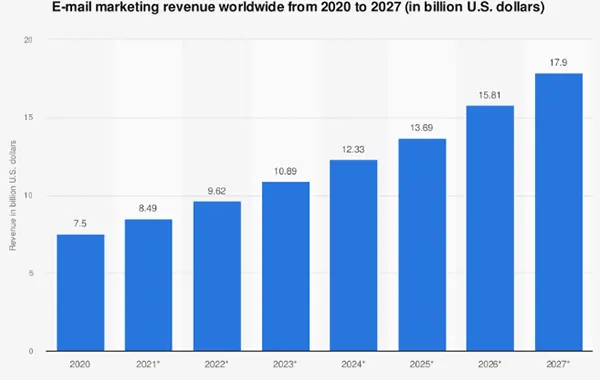How to Calculate Salary in Your Email Marketing Business

If you are wondering how to calculate salary in the email marketing job, we have all the details. Calculating earnings, an integral part of financial management requires understanding various factors that influence how much one can afford to pay for oneself and the team.
The average return on investment (ROI) for email marketing is $42 for every $1 spent, highlighting the profitability potential of this business model and its impact on salary budgeting.
This article delves into the nuances of earning calculation in email marketing, guiding through the process to ensure the business thrives.
Understanding Your Revenue Streams
Email marketing derives income from multiple sources, including affiliate commissions, sponsored content, and direct product or service sales. Imagine you’re crafting campaigns that resonate with the audience, leading to a spike in affiliate commissions. Next month, perhaps a high-value sponsored content deal will land in your lap.
Considering how unpredictable the income can be, it’s a good idea to have a detailed plan that includes every possible scenario. This will allow you to calculate income and reflect the real-world ups and downs of the company.
Determining Salary Structure
Many factors can determine the salary structure. For example, choosing between fixed income and performance-based incentives can significantly impact the business’s financial health.
Many companies go for the hybrid approach that offers a base pay to cover basic living expenses while using incentives to drive performance and growth. This way, the employees have a secure earning they can rely on, and the bonuses depend on their performance, motivating them to work more efficiently.
Operational Costs and Profit Margins

This graph shows the email marketing revenue worldwide from 2020 to 2027, in US$ billion.
Let’s talk about the less glamorous side of running a related business: operational costs. These are the silent currents beneath the surface, from the tools that power the campaigns to the platforms that host the content. Each expense is a necessary part of the journey, but they can quickly add up, nibbling away at the profit margins.
The average cost of email marketing tools and services accounts for approximately 15-20% of operational figures, underscoring the importance of budget allocation in managing overall expenses and salary calculations.
The trick is to navigate these waters with a keen eye, ensuring that every dollar spent brings value to the business. Remember, a ship that’s too heavy with unnecessary costs will struggle to sail swiftly.
Calculating Salaries: A Step-by-Step Guide
Once you understand the profit streams and have the basic income structure, it’s time to determine the actual pay in the email marketing business.
Step 1: Calculate Monthly Revenue
Break down the income sources – how much is coming from affiliate marketing, sponsored content, direct sales, and any other streams? Use historical data to identify trends and seasonality in the business. This will not only give you a snapshot of the current financial health but also help you predict future interest streams. Think of it as the business’s pulse check.
Step 2: Deduct Operational Costs
Now, roll up your sleeves because it’s time to subtract the operational amounts from the revenue. This includes everything from software subscriptions and marketing expenses to rent (if you have a physical office) and salaries (yes, you need to account for current salaries to plan for future ones).
Be meticulous here; even the smallest costs can add up, affecting the bottom line. Tools like accounting software can be incredibly helpful, turning what could be an overwhelming task into a manageable one.
Step 3: Determine Profit Margins
With the profit and costs laid out, calculating the profit margin is next. This is the percentage of the revenue that remains after covering all operational expenses. It’s a vital indicator of the company’s financial health and its ability to sustain and grow.
A healthy profit margin means you have a buffer to invest back into the trade, innovate, and, yes, calculate earnings.
Step 4: Decide on Salary Percentage from Profits
This is where you decide how much of the profits you’ll allocate to salaries. There’s no one-size-fits-all answer, but a good rule of thumb is to ensure this number aligns with the goals and the competitive landscape of the industry.
When operating in specific regions, like New Jersey, it’s pivotal to consider local earning adjustments or legal requirements. This could mean adjusting for the amount of living or adhering to minimum wage laws. It’s here you might want to use a tool to calculate your paycheck in New Jersey, ensuring the salaries are not only competitive but also compliant with state regulations.
Adjusting Salaries Based on Performance and Revenue Changes
As your email marketing evolves, so too should the approach to salaries. The digital landscape is ever-changing, and flexibility is key to staying ahead.
No matter if it’s integrating new revenue streams, adjusting to market shifts, or adopting new technologies, the pay structure needs to be as dynamic as the environment you operate in. This adaptability not only ensures financial health but also signals to the team that you’re committed to fairness and growth.
Do You Know?
89% of marketers use email as the main channel for generating leads.
Conclusion
Accurately calculating salaries in an email marketing business is not just about numbers; it’s about strategically managing resources to support your team and company’s growth.
By understanding the revenue streams, operational costs, and profit margins and by leveraging the right tools, you can establish a salary structure that rewards performance and ensures the organization’s financial health. With the strategies outlined in this article, you’re equipped to navigate the complexities of income calculation, paving the way for a prosperous email marketing venture.
Share















